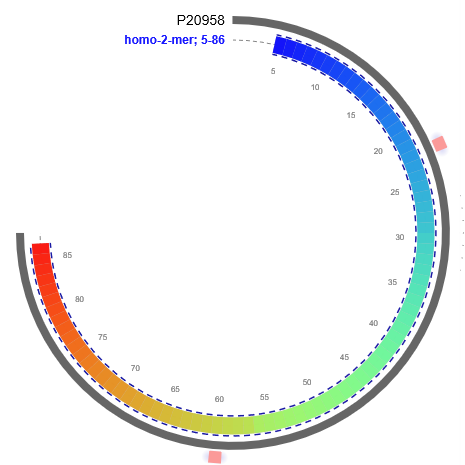Diheme cytochrome that function as the electron transport subunit of sulfide dehydrogenase.
APEQSKSIPRGEILSLSCAGCHGTDGKSESIIPTIYGRSAEYIESALLDFKSGARPSTVM
GRHAKGYSDEEIHQIAEYFGSLSTMNN88

| PMID | Title & Author | Abstract | Year | |
| 0 | 28864655 | Cupriavidus necator H16 Uses Flavocytochrome c Sulfide Dehydrogenase To Oxidize Self-Produced and Added Sulfide. Lü C, Xia Y, Liu D, Zhao R, Gao R, Liu H, Xun L. | Production of sulfide (H2S, HS-, and S2-) by heterotrophic bacteria during aerobic growth is a common phenomenon. Some bacteria with sulfide:quinone oxidoreductase (SQR) and persulfide dioxygenase (PDO) can oxidize self-produced sulfide to sulfite and thiosulfate, but other bacteria without these enzymes release sulfide into the medium, from which H2S can volatilize into the gas phase. Here, we report that Cupriavidus necator H16, with the fccA and fccB genes encoding flavocytochrome c sulfide dehydrogenases (FCSDs), also oxidized self-produced H2S. A mutant in which fccA and fccB were deleted accumulated and released H2S. When fccA and fccB were expressed in Pseudomonas aeruginosa strain Pa3K with deletions of its sqr and pdo genes, the recombinant rapidly oxidized sulfide to sulfane sulfur. When PDO was also cloned into the recombinant, the recombinant with both FCSD and PDO oxidized sulfide to sulfite and thiosulfate. Thus, the proposed pathway is similar to the pathway catalyzed by SQR and PDO, in which FCSD oxidizes sulfide to polysulfide, polysulfide spontaneously reacts with reduced glutathione (GSH) to produce glutathione persulfide (GSSH), and PDO oxidizes GSSH to sulfite, which chemically reacts with polysulfide to produce thiosulfate. About 20.6% of sequenced bacterial genomes contain SQR, and only 3.9% contain FCSD. This is not a surprise, since SQR is more efficient in conserving energy because it passes electrons from sulfide oxidation into the electron transport chain at the quinone level, while FCSD passes electrons to cytochrome c The transport of electrons from the latter to O2 conserves less energy. FCSDs are grouped into three subgroups, well conserved at the taxonomic level. Thus, our data show the diversity in sulfide oxidation by heterotrophic bacteria.IMPORTANCE Heterotrophic bacteria with SQR and PDO can oxidize self-produced sulfide and do not release H2S into the gas phase. C. necator H16 has FCSD but not SQR, and it does not release H2S. We confirmed that the bacterium used FCSD for the oxidation of self-produced sulfide. The bacterium also oxidized added sulfide. The common presence of SQRs, FCSDs, and PDOs in heterotrophic bacteria suggests the significant role of heterotrophic bacteria in sulfide oxidation, participating in sulfur biogeochemical cycling. Further, FCSDs have been identified in anaerobic photosynthetic bacteria and chemolithotrophic bacteria, but their physiological roles are unknown. We showed that heterotrophic bacteria use FCSDs to oxidize self-produced sulfide and extraneous sulfide, and they may be used for H2S bioremediation. | 2017 |
| 1 | 9560424 | A periplasmic flavoprotein in Wolinella succinogenes that resembles the fumarate reductase of Shewanella putrefaciens. Simon J, Gross R, Klimmek O, Ringel M, Kröger A. | During growth with fumarate as the terminal electron transport acceptor and either formate or sulfide as the electron donor, Wolinella succinogenes induced a peri-plasmic protein (54 kDa) that reacted with an antiserum raised against the periplasmic fumarate reductase (Fcc) of Shewanella putrefaciens. However, the periplasmic cell fraction of W. succinogenes did not catalyze fumarate reduction with viologen radicals. W. succinogenes grown with polysulfide instead of fumarate contained much less (< 10%) of the 54-kDa antigen, and the antigen was not detectable in nitrate-grown bacteria. The antigen was most likely encoded by the fccA gene of W. succinogenes. The antigen was absent from a DeltafccABC mutant, and its size is close to that of the protein predicted by fccA. The fccA gene probably encodes a pre-protein carrying an N-terminal signal peptide. The sequence of the mature FccA (481 residues, 52.4 kDa) is similar (31% identity) to that of the C-terminal part (450 residues) of S. putrefaciens fumarate reductase. As indicated by Northern blot analysis, fccA is cotranscribed with fccB and fccC. The proteins predicted from the fccB and fccC gene sequences represent tetraheme cytochromes c. FccB is similar to the N-terminal part (150 residues) of S. putrefaciens fumarate reductase, while FccC resembles the tetraheme cytochromes c of the NirT/NapC family. The DeltafccABC mutant of W. succinogenes grew with fumarate and formate or sulfide, suggesting that the deleted proteins were not required for fumarate respiration with either electron donor. | 1998 |
| 2 | 23067389 | Mind the gap: cytochrome interactions reveal electron pathways across the periplasm of Shewanella oneidensis MR-1. Fonseca BM, Paquete CM, Neto SE, Pacheco I, Soares CM, Louro RO. | Extracellular electron transfer is the key metabolic trait that enables some bacteria to play a significant role in the biogeochemical cycling of metals and in bioelectrochemical devices such as microbial fuel cells. In Shewanella oneidensis MR-1, electrons generated in the cytoplasm by catabolic processes must cross the periplasmic space to reach terminal oxidoreductases found at the cell surface. Lack of knowledge on how these electrons flow across the periplasmic space is one of the unresolved issues related with extracellular electron transfer. Using NMR to probe protein-protein interactions, kinetic measurements of electron transfer and electrostatic calculations, we were able to identify protein partners and their docking sites, and determine the dissociation constants. The results showed that both STC (small tetrahaem cytochrome c) and FccA (flavocytochrome c) interact with their redox partners, CymA and MtrA, through a single haem, avoiding the establishment of stable redox complexes capable of spanning the periplasmic space. Furthermore, we verified that the most abundant periplasmic cytochromes STC, FccA and ScyA (monohaem cytochrome c5) do not interact with each other and this is likely to be the consequence of negative surface charges in these proteins. This reveals the co-existence of two non-mixing redox pathways that lead to extracellular electron transfer in S. oneidensis MR-1 established through transient protein interactions. | 2013 |
Reinartz M , Jürgen Tsch?pe, Thomas Brüser, et al. Sulfide oxidation in the phototrophic sulfur bacterium Chromatium vinosum[J]. Archives of Microbiology, 1998, 170(1):59-68.